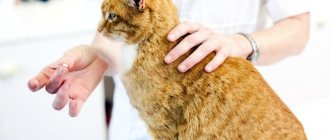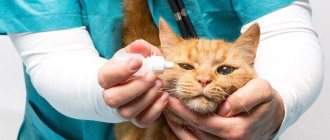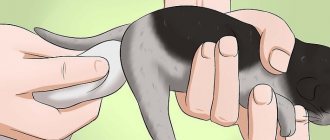Helminths and worms are parasitic worms that cause the appearance of parasites in humans and animals. Parasite eggs can be in the ground, on grass, in rivers and lakes, in raw animal products, on poorly washed fruits, etc.
You don’t have to let a cat outside, however, this does not guarantee that the animal will not become infected with helminths. Cat worms easily spread to people, and children are especially often infected with them.
A domestic cat can get worm eggs from our clothes or from outdoor shoes. A large number of varieties of worms present in the body of domestic animals can also cause harm to us. Kittens and cats can experience any type of helminths; parasites can settle in the intestines, lungs and other organs. As a rule, tapeworms or roundworms appear in the body of cats.
The only option to protect your pet from infection is to worm him regularly, without ignoring his protection from fleas.
At the Murkosha shelter, animals undergo mandatory preventive measures and, if necessary, undergo treatment for parasites.
Read more: “Treatment for parasites”
Deworming of domestic cats in our shelter is a set of special measures that are aimed at cleansing the animal’s body of eggs and larvae of worms and preventing the appearance of parasites.
Helminths infect the mucous membranes of various organs of the cat and live off their tissues and blood. Any parasites that infect an animal release substances during their life processes that can cause poisoning. Worms in a cat can cause weakness and decreased immunity over time. At an advanced stage, intestinal rupture may occur, and this can be fatal.
How can parasites settle in a cat's body?
This point often worries owners of domestic cats. The answer is quite simple - your pet’s diet contains raw fish or meat, waste, flies, all of which can cause infection. In addition, mother cats can transmit helminths to their kittens through milk.
Read more: “Proper nutrition for cats”
Worms can easily pass from cats to humans through skin tissue or fleas.
The presence of special signs of infection in an animal is determined by the degree of disease and the number of parasites in the cat’s body. Symptoms differ between cats and small kittens, and this is also influenced by the type of helminth present. The main signs of the presence of worms can be:
- vomit;
- diarrhea or frequent constipation;
- Individual larvae or even worms may be observed on the cat’s fur or near the anus;
- kittens and cats may be bothered by itching of the anus;
- there is stool with blood or mucus;
- round and dense belly;
- long-term weight loss;
- changes in appetite;
- cough, difficulty breathing;
- heavy shedding;
- underdevelopment of the kitten’s physical characteristics;
- fast fatiguability;
- pallor or yellowness of the mucous membranes;
- premature birth.
Cat owners need to take into account that these symptoms are similar to signs of various infections. If the cat is dewormed at this point, the course of the infection may become more complicated, which in some cases leads to death. In this case, it is necessary to establish an accurate diagnosis; this can only be done by a qualified veterinarian. In our Murkosha shelter, animals can receive timely and professional help.
Read about how to help your cat here: “Signs of an Unhealthy Cat”
If a pet owner suspects that their cat has worms, it is necessary to treat it immediately. You shouldn’t delay this, since the appearance of several signs of worms immediately indicates that parasites are already living in large numbers in your cat’s body.
What drugs exist
Preparations intended for deworming cats come in narrow and broad spectrum. The former affect a specific type of parasite, while the latter affect several at once.
Thanks to the variety of release forms, the anthelmintic can be easily selected individually. It can be given in the form of tablets or suspensions, or simply dripped onto the withers. Each form has its own advantages and disadvantages. After reading them, you will understand how easier it is to deworm your cat.
Pills
The advantages of the tablet form are a longer shelf life and the possibility of localizing the action of the drug in a specific part of the gastrointestinal tract. This is achieved by applying a special coating that allows the active substance to be transported to the required location.
The downside of such medications is their slow action and the impossibility of use for frequent bouts of vomiting. The owners also have problems with feeding the tablets. Because of the bitter taste, animals often refuse to take them on their own, so the procedure is carried out forcibly.
Suspensions
First of all, suspensions are attractive due to their fast action. When the active substances are crushed, their surface area increases, allowing contact with a larger part of the organ or tissue infected with worms.
Another advantage is a more pleasant taste, which is achieved in production using flavoring agents. The taste of meat is accepted with a bang by mustachioed pets. Suspensions are often produced together with a dispenser syringe, which allows you to measure the required amount of medicine and inject it into the cat’s mouth.
If you have several pets, then treat them with one drug, choosing a convenient release form.
The disadvantages of suspensions include short service life and physical instability. The resulting sediment disrupts the uniformity of dosing.
Drops
Drops are applied only to the withers - a place that the animal cannot reach. To get the effect, just a couple of drops are enough, so owners choose this form because of its economical consumption and ease of use.
Swimming is excluded for 2 days before and after use. Water can wash away the protective barrier on the skin or the droplets themselves. In the first case, the pet will receive more toxins, and in the second, it will not feel the effect and will remain vulnerable to worms.
Please note that due to their gentle action, drops are not suitable for direct infestations. If helminthiasis is detected, it is recommended to use other anthelmintics, and the drops will act as a protective agent after getting rid of the worms.
Folk remedies
Traditional medicine is recommended for young people, pregnancy and lactation. It has no harmful effects on the body and is suitable even for weakened pets. Its only drawback is its slow action. Treatment will take from 7 to 30 days. There is also a risk of an allergic reaction.
To remove worms use:
- Infusion of wormwood and tansy. Grind the plants in equal proportions, pour boiling water over them and filter to remove small particles. For 1 tbsp. l. 250 ml of water is enough. The cooled infusion is taken an hour before morning feeding for 7 days.
- Pumpkin seed infusion. Pour boiling water over the peeled and crushed seeds, adding a little honey. After 12 hours, strain the infusion and serve half an hour before meals. The medicine can be given orally or through enemas.
- Tansy flowers. In addition to the green part, the buds themselves also have healing properties. Add peppermint, buckthorn bark and wild carrot seeds. Prepare the same way with tansy and wormwood, taking 2 times more herbal mixture. Give it three times a day for 3 days.
Before using folk remedies, be sure to consult your veterinarian. Some recipes may be dangerous.
It is strictly forbidden to use onions and garlic. These products contain chemicals that destroy feline red blood cells. Hemolytic anemia may be added to helminthiasis. Poisoning by these plants is accompanied by severe vomiting, diarrhea, pale mucous membranes and difficulty breathing.
How to remove worms from cats: a professional approach
If unskilled actions are taken, your animal may even die, so before treating worms, you need to clarify the type of parasites that your cat is infected with, as well as the presence of other infections. Currently, there are drugs for removing tapeworms, however, they will not be effective against, for example, roundworms. And broad-spectrum products can be dangerous for your cat.
At the moment, excellent foreign and Russian remedies are known for the treatment of different types of worms: Dirofen, Panacur, Polyvercan, Febtal, Profender (used once), Kanikquantel, Trontsil K, Prazitel, Pirantel (can be used even for kittens, guaranteed not to provoke poisoning) .
Never buy anti-worming medications at markets or street stalls; they should only be purchased at veterinary institutions or specialized pharmacies if you do not want to harm your pet.
Before deworming, it is necessary to remove fleas from the animal. This procedure should not be neglected, otherwise helminth eggs will reappear in the cat along with the insects. Give preference to flea control products, guided by the following nuances:
- no toxicity;
- the presence of the necessary labeling if the product is chosen for kittens;
- You should not choose external medications for a nursing or pregnant cat or kitten, they can be poisoned.
What to do if your cat spits out medicine
Zoologists say: refusal to take a drug is an absolutely normal reaction of a healthy animal, which must be accepted.
If your pet categorically refuses the medication and spits out the pills, you can postpone the procedure for a short time. Wait until your cat calms down before trying to give her the medicine again.
Also, instead of tablets, you can give another form of the drug: drops, suspensions, pastes.
Features of the use of anthelmintic drugs
Tablets for removing helminths are divided into cats and kittens; you need to be careful in the dosage. An overdose of anthelmintic drugs can be fatal for a kitten, since almost any anthelmintic drug is toxic, especially those drugs that are used externally on the animal’s withers. They should not be used on old or infected cats or kittens.
For a small kitten, purchase a liquid suspension. Cats can be dewormed from 2 months of age, immediately before vaccination. However, there are products that are suitable for animals only from 3 months - Trontsil-K, Kanikvantel, Febtal.
Be attentive to your pets during treatment:
- you can inject Gamavit into the withers with a medicine for worms (the dose depends on age, varies from 0.5 to 3 ml);
- after the anthelmintic drug, be sure to give the cat any sorbent - it can be activated carbon (kitten - from 0.5 to 1 tablet, cat - 1-1.5) or Enterosgel (for kittens, dilute half a teaspoon according to the attached instructions, for adults you can give one teaspoon);
- After taking the drug, watch how your animal goes to the toilet; if the cat cannot go to the toilet, there is a possibility of intoxication. In this case, 5-7 ml of Duphalac and the same amount of Vaseline will help;
- if you are treating your animal, the process should be repeated after 10-12 days. If you dewormed your cat as a preventive measure, one course will be enough.
Remember, cats expecting offspring or nursing kittens should not be given anthelmintics!
Precautionary measures
Deworming must be not only effective, but also safe. To do this you need:
- Make sure your pet is healthy. The skin should be free of dandruff and wounds, the nose should be wet and cool, the eyes should be clean and free of purulent discharge. It is recommended to measure the animal's body temperature rectally. If it exceeds +38°C, it is better to show the cat to a veterinarian and only then give medicine.
- Use a high-quality anthelmintic. Some manufacturers use active ingredients that instantly kill parasites and provoke their decomposition in the intestines. Because of this, the animal experiences severe intoxication. Veterinarians do not recommend using cheap medications (Bars and its analogues). It is better to choose the most gentle anthelmintic drug, even if it is expensive, than to treat a cat from the consequences of taking low-quality tablets.
- Know the date of previous deworming. Anthelmintic drugs should not be given more than once every 3 months. The active substance accumulates in the blood and is eliminated from the body for a long time. An exception can be made only in case of severe helminthic infestation. In this case, the medicine is given again after 10 days.
- Teach your pet to regular preventative care from an early age. Over time, he will get used to it and will calmly respond to taking medications.
- Remove fleas and ticks if present. Through them, worm eggs are often transmitted, so even after eating an anthelmintic tablet, the cat can become infected again. It is recommended to give medicine against parasites only 3 days after removing fleas.
The owner’s calm behavior is the main rule of how to give a cat a deworming pill without damaging its psyche. If a pet feels a person’s confidence, he trusts and is more willing to take the necessary drug.
How to give the tablet to cats and kittens?
If you want to cure a kitten, it is better to immediately buy a liquid suspension. When it is necessary to cure worms in an adult animal, tablets should be given in one of the following ways:
- The cat should sit with its back to you; it is better to sit it on your lap, since when trying to escape, the animal begins to back away. With one hand you should unclench the cat's jaws, with the other you should put the deworming drug into the mouth. Then stroke the animal's throat to trigger the swallowing reflex;
- You can crush the tablet and dissolve it in liquid. Pour the resulting mixture from a syringe without a needle behind the cat’s cheek, gently hold its muzzle so that it does not spit out the medicine;
- the cat is ready to swallow even an unloved treat if you show extra affection, pet it and talk to it. The crushed tablet can be mixed with liquid food, boiled minced meat or chopped meat, then given to a kitten or cat;
- You can treat a particularly violent pet for helminths in this way - wrap it in a blanket, leaving only the head exposed. Place the cat with its back facing up to prevent choking. After that, use method 1 or 2;
- You can worm a cat without it even realizing what happened. To do this, you can use a small piece of butter into which you need to roll the tablet. Place this pellet in the freezer for 10-15 minutes. Use the swaddling method, making sure your cat swallows the oil.
Additional ideas
- The animal should not be wrapped in a blanket. You can try to do it without using force. You can put it on the table and turn it away from you. The main thing is not to show the cat the medicine in advance.
- Before giving your cat deworming medicine, you need to prepare everything first. The tablet must be removed from the blister and, if necessary, crushed. When administering the drug, every second will count.
- In order to properly open your pet's mouth, you need to insert your finger between the front teeth. Then firmly but painlessly press on the lower jaw.
- To make the cat more flexible, you can hold it by the withers.
- Never let your cat go until she licks her lips. If she licks her lips, then this is a sign that she has swallowed the medicine.
- Deworming tablets, which have an extremely unpleasant odor and taste, can be kept in the refrigerator before use. Cold can reduce odor and eliminate bitterness at least for the duration of taking the product.
If after treatment the animal is poisoned
As a rule, possible complications after treatment for worms arise due to poisoning of the body, provoked by the decomposition of dead parasites inside the cat. Malaise sometimes occurs due to inaccurate dosage of medications used to treat an infected pet, as well as due to intolerance to a particular medication. If vomiting occurs, the cat has difficulty breathing, muscle tremors or increased lethargy are observed, it is necessary to urgently call a veterinarian.
At the Murkosha shelter, worms are poisoned from admitted kittens only after all possible infections have been excluded and under the strict supervision of a veterinarian. Treatment should begin no earlier than 2 weeks after you take the kitten into your home, provided that it is absolutely healthy. Also, you should not immediately use different drugs - for helminths, fleas, ticks, etc., otherwise intoxication cannot be avoided.
Medicines for worms: main list, names, prices
In veterinary medicine, complex drugs are most often used against several types of different parasitic worms. To choose a medicinal product, it is best to contact a veterinarian, who will prescribe the drug based on the animal’s health condition and having done a preliminary fecal analysis to determine the type of helminthic infestation (type of parasites). The initiative of owners of mustachioed pets in a veterinary pharmacy in the form of the phrase “give something for worms to the cat” can lead to serious consequences!
All anthelmintic drugs are difficult to tolerate by any living organism - this is always a burden on the liver and immune system. An incorrectly calculated dosage or an incorrectly selected drug is a real risk of death of the animal!
It is strictly forbidden to give cats human deworming medications. It is almost impossible to safely calculate the current dosage for a person by the weight of a cat.
Absolutely all deworming tablets for cats are accompanied by instructions with a detailed description of the dosage calculation, methods of use and warnings.
Deworming tablets
Dirofen plus 35-70 rub.
Tablets for kittens: 1 tablet/kg; for adult cats: 1 tablet/5 kg. Three days in a row once, repeated after 2 weeks.
Contraindications - Do not violate the treatment regimen. Not for kittens under 3 weeks of age. Pregnant women - no later than 3 weeks before birth, breastfeeding - no earlier than 2-3 weeks after birth.
In case of overdose: depression, drooling, indigestion, lack of appetite.
Milbemax 200-400 rub.
For cats: 2-4 kg – 0.5 tablet; 4-8 kg – 1 tablet. For kittens: 0.5-1 kg – 0.5 tablet; 1-2 kg – 1 tablet. One time.
Contraindications: pregnant women under medical supervision. Not allowed: up to 6 weeks for kittens who are malnourished, have kidney or liver failure.
Allergic reactions are possible.
Drontal
60-80 rub./tab.) 1 tablet/4 kg of weight once in the morning feeding.
Contraindicated: individual sensitivity to components, age under 3 weeks and weight less than 1 kg, pregnancy.
Trontsil K
180-250 rub. Calculation of dosage by weight: up to 1 kg - ? tab., 1-2 kg – ? tab., 2-3 kg – ? tab., 3-4 kg - 1 tab., 4-5 kg - 1 and ? tab.
Febtal
35-55 rub. Once in the morning for three days. 1 tablet/3 kg weight. It is better to crush it in food.
Poliverkan
200-300 rub. Dissolve in water. Once, repeated after 10 days. 0.5 kg – 0.25 briquettes; 1-5 kg – 0.5 briquettes;
Contraindications: hypersensitivity, liver dysfunction, age up to 30 days.
Prazitel
50-80 rub. Form for adult cats: 1 tablet/4 kg weight; for kittens: 1 tablet/kg. One time. Repeat after 10 days in case of severe infection.
Possible: individual reaction, increased salivation.
Kanikquantel Plus
45-60 rub. 1 tablet/10 kg body weight with food. Can be crushed and diluted in 10 ml of water, giving 1 ml/kg of suspension.
Contraindicated: pregnancy, feeding, kittens under 3 weeks of age.
Fenpraz
120-137 rub. Inside, once in the morning. 1 tablet/4 kg weight.
Not allowed: for pregnant women - no later than 10 days before the expected lambing.
Anti-worm suspensions
Prazicide
40-60 rub. 1 ml/kg body weight once in the morning. Repeat in 10 days.
3 weeks before birth and 2-3 weeks after.
Prazitel
100-150 rub. Once, repeated after 10 days at a dose of 1 ml/kg.
First half of pregnancy and kittens up to 3 weeks of age. Brief drooling may occur.
Febtal combo
50-80 rub. Dose: 1 ml/kg. For weights up to 0.5 kg, the collected dose is diluted with 0.3 ml of water.
Pregnancy, feeding offspring, kittens up to 3 weeks old.
Fenpraz
100-125 rub. 1 ml/2 kg weight with a small amount of water in a syringe or food. Give slowly! Once in the morning or evening.
For pregnant women, under the supervision of a doctor and no later than 1.5 weeks before birth.
Anthelmintic drops on the withers
Profender
200-310 RUR/pipette. 1 pipette of the required volume per 1 animal, depending on the size of the animal: 0.5-2.5 kg – 0.35 ml; 2.6-5 kg – 0.7 ml; 5-8 kg – 1.2 ml. For cats heavier than 8 kg, the calculation is 0.14 ml/kg. It drips onto the withers (neck and between the shoulder blades).
Individual reaction. Do not apply to wet or damaged skin. Kittens under 8 weeks and less than 0.5 kg.
Itching and local irritation.
Inspector
150-350 rub./pipette. 1 pipette according to the weight of the animal: 1-4 kg – 0.4 ml, 4-8 kg – 0.8 ml. Once on the withers on the skin.
Pregnancy, nursing, weighing up to 1 kg - according to indications and under the supervision of a doctor.
Sometimes a local reaction in the form of itching and irritation.
Helminthal
100-200 rub./pipette. On the skin of the withers in 3-4 different places, excluding licking. 1 pipette – 1 animal: up to 4 kg – 0.4 ml; 4-10 kg – 1 ml. One time.
Individual reaction, kittens younger than 7 weeks, weak, sick and exhausted cats, pregnancy, lactation, kidney and liver problems.
Rare local reactions (irritation and itching).
Prazicide complex
160-270 rub./pipette. Up to 1 kg kittens – 1 pipette 0.3 ml; more than 1 kg – 0.6 ml (2 pipettes); cats up to 5 kg – 1 pipette 0.85 ml; over 5 kg – 2 pipettes 1.7 ml. One time.
Kittens under 2 months old, lactating and pregnant individuals, sick and exhausted.
Broadline
450-570 RUR/pipette. On the skin in the withers area once, according to the dosage markings on the syringe: up to 2.5 kg - 0.3 ml; 2.5-7.5 kg – 0.9 ml; 7.5-10 kg – 1.2 ml.
Impaired kidney and liver function, weak and emaciated individuals, kittens up to 7 weeks old, lactation, pregnancy.
Antihelminthic pastes
Dirofen paste 20
120-200 rub. Once in the morning, 1 mg of paste per 1 kg of weight immediately into the mouth or with food. Repeat after 1.5 weeks.
Kittens under 3 weeks of age, sick, malnourished and recovering cats. Pregnant and breastfeeding women should use caution under the supervision of a doctor 3 weeks before and 2-3 weeks after birth.
In case of overdose, obvious signs of intoxication: depression, refusal to feed, vomiting.
Kaniverm
0.5 ml paste/0.5-2 kg weight; 1 ml/2-5 kg depending on the intensity of the invasion. Do not combine with dairy products. Repeat after 3 weeks.
Hypersensitivity to components, liver damage. Pregnant women are prohibited from exceeding the dose.
Preventive measures for the appearance of parasites
Worms can appear even in the healthiest cat, so prevention won’t hurt:
- make sure your cat does not suffer from fleas;
- remove raw foods from the animal’s diet;
- regularly replace the filler in the pot, do not forget to disinfect the tray;
- keep your shoes out of reach of your pet;
- adhere to basic hygiene rules - wash your hands thoroughly after interacting with your cat, do not allow licking of the face;
- It is necessary to deworm pets 4 times a year; if a cat walks outside, deworming should be carried out more often;
- Parasite prevention should be done 2 weeks before vaccinations.
This point must be taken into account, since vaccination is the receipt by the animal’s body of a certain set of weak viruses. The cat’s immune system processes the received funds for some time. If parasites are present, the animal’s immunity is already weakened. Therefore, the cat’s body will not be able to properly resist the viruses introduced with the vaccination, that is, the vaccination will lose its effect. In addition, vaccination can cause illness or poor health of the animal.
If you have taken several cats or kittens into your home, prevent and treat helminths for all animals at the same time. Products used for humans should not be used to treat cats.
Why worm a cat?
Worm infestation is the most common disease that occurs in domestic cats . Such internal parasites can cause quite serious harm to a pet, and are sometimes deadly. Some species are able to remain in the animal’s body for many years without showing themselves at all:
- Tapeworms, including the cucumber tapeworm, can grow very large inside a cat's intestinal tract, reaching lengths of up to half a meter. Adult helminths are able to attach well to the intestinal mucosa through special suction cups and hooks, causing very strong inflammatory processes. Among other things, cucumber tapeworm is often transmitted from pet to owner;
- flatworms, including the liver fluke, parasitize the internal organs of the cat, causing severe damage and disorders. Cat fluke or Siberian fluke is affected by eating contaminated fish. The first signs of helminthic infestation are fever and severe weakness, as well as jaundice, vomiting, digestive problems and hair loss. In humans, opisthorchiasis causes liver cirrhosis or hepatocellular carcinoma;
- roundworms, or so-called toxocara, live inside the small intestine. Such helminths can quite deplete the body of a pet, causing severe disturbances in the digestive process, as well as frequent vomiting. This internal parasite is especially dangerous for small kittens, in which roundworms can cause blockage and subsequent rupture of the intestines.
It is very important to remember that tape and round helminths, which often parasitize the body of a domestic cat, can be quite easily transmitted to humans, including small children.
Important! To effectively prevent infection with helminths of any type, it is very important to carry out prevention, as well as timely and correct anthelmintic measures.
Return to content
Side effects
Worming tablets used for cats have a number of side effects. This directly depends on how toxic the medicine is. The age and general condition of the animal plays an important role. If all requirements specified in the instructions are strictly followed, there should be no side effects.
- If you are hypersensitive to one of the components in the medication, foaming and allergic itching may occur.
- Gastrointestinal tract disorders occur. Which are usually expressed in the form of loose stools, decreased appetite, and vomiting.
After one day after taking the anthelmintic drug, the side effects usually go away. If the signs persist longer, you should seek help from a veterinarian.
Release form of anthelmintic drugs
Modern veterinary medicine can offer different remedies for cat worms. These drugs come in a variety of release forms.
- A variety of deworming tablets used for cats.
- Anthelmintic drops.
- Pasty products.
- Anthelmintic suspension.
- Anthelmintic drops applied to the pet's withers.
- Antihelminthic injections.
Which medications to choose at the pharmacy directly depends on the cat and its owner. The release form does not have any effect on the effectiveness of the drug. Not all owners are able to correctly administer deworming tablets invented for cats. If the animal cannot swallow the solid form of the drug, then it can be easily replaced by a suspension that can be easily added to the animal’s food. For kittens, anthelmintic drops that are rubbed into the withers would be ideal, but in such a way that the pet cannot reach them with his tongue and lick them off.
How to determine whether you need to deworm
An adult and strong animal has a high resistance to helminths, so determining the presence of worms can be quite difficult. The main symptoms of infection of a pet with endoparasites are:
- the appearance of lethargy and fatigue;
- signs of the presence of helminths or their eggs in feces;
- intestinal disorder characterized by alternating constipation and diarrhea;
- sudden weight loss;
- the presence of severe bloating and increased density in the abdominal area;
- refusal to eat;
- the appearance of vomiting;
- hair loss or dullness;
- manifestations of restlessness and severe nervousness.
The symptoms of infestation of a pet with worms are very similar to the appearance of signs of other, very dangerous and quite serious cat diseases, so the need to carry out anthelmintic measures must necessarily be supported not only by external manifestations, but also by test results.
This is interesting! A veterinary examination of a pet, confirming the need for deworming, includes not only standard tests, but also a diagnostic examination of the animal by a specialized doctor.
Return to content











